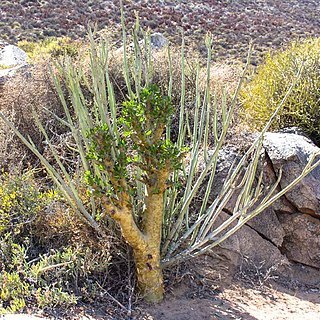Leaves 1-foliolate or very rarely (? only at the northern extremity of the range in N. Rhodesia) with very much smaller lateral leaflets; petiole up to 2 mm. long, glabrous or with a few minute glands and 4: pilose; leaflet-lamina up to 7·5 × 3·2 cm. (but usually smaller), narrowly obovate to obovate or more rarely elliptic, apex acute or sometimes obtuse, margins crenate-serrate, base cuneate, glabrous on both surfaces or with a few scattered glands especially towards the base of the midrib, rarely shortly pubescent when very young.
A sprawling, spiny shrub. It grows to 8 m high. The bark is grey, green, yellow or red and flakes in small papery strips. The leaves are clustered on short spiny branches. The leaves are compound but have a single leaflet. It is narrowly oval and 7.5 cm long by 3.2 cm wide. They are bright green above and paler underneath. The flowers are small and pink. They are in clusters on very small branches. The fruit are oval and about 10 mm long. The stone has a 3 or 4 armed false seed layer.
Polygamous or dioecious many-stemmed shrub or small tree, up to 3 m high. Bark yellow to green, flaking In yellowish papery pieces to expose green underlayer. Branchlets spine-tipped. Leaves simple or 3-foliolate; lamina elliptic, narrowly obovate or obovate, margin finely crenate-serrate. Flowers yellowish green to red.
Fruit c. 9 × 7 mm., broadly ellipsoid, somewhat asymmetric with abruptly pointed apex, glabrous; pseudaril with 3 (4) arms; endocarp c. 7 × 5 mm., smooth.
Low spreading much-branched shrub 1–2 m. tall or a small tree up to c. 8 m. tall, spiny, bark grey and papery; young branches glabrous.
Flowers appearing before the leaves in subsessile clusters on short side-shoots or on the spines.
Calyx c. 2 mm. long, lobed to halfway, glabrous or ± densely glandular.
Stamen-filaments slender, subterete.
Petals 4–5 mm. long.
Disk-lobes 4.


